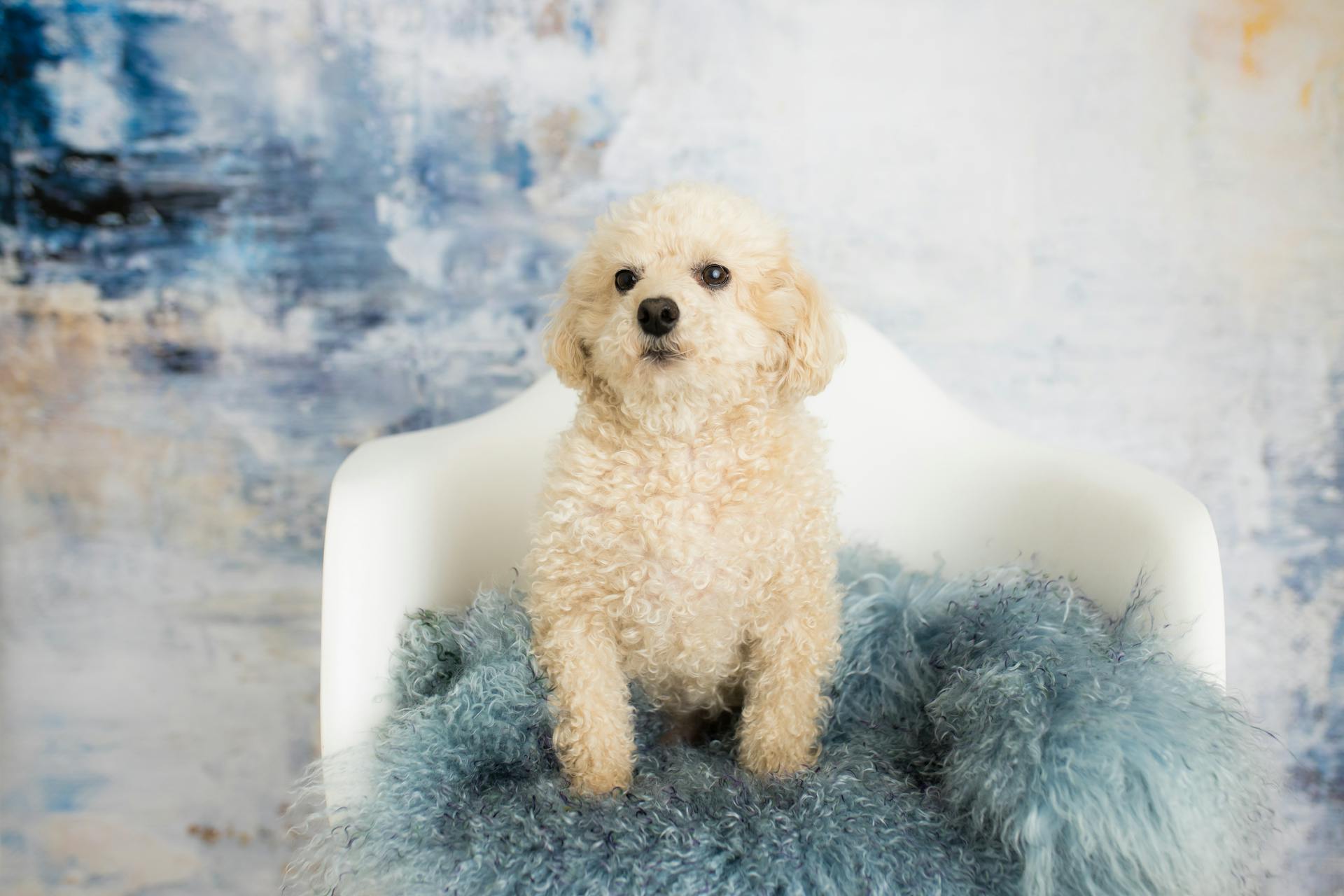
Toy Poodles are naturally curious dogs, and with proper care, they can learn to love the water. They have a low-shedding coat that's prone to matting, so it's essential to brush them regularly to prevent tangling.
Toy Poodles are generally a healthy breed, but they can be prone to certain health issues, such as patellar luxation and eye problems. These conditions can be managed with regular veterinary check-ups and a balanced diet.
With their small size and athletic build, Toy Poodles can be natural swimmers, but they need to be introduced to water gradually to avoid stress and anxiety. They should start with shallow water and gradually increase the depth as they become more comfortable.
Readers also liked: How Cold of Water Can Dogs Swim in
Teaching Your Toy Poodle to Swim
You can start teaching your toy poodle to swim at around 6 months of age, but every poodle is different.
To get your toy poodle comfortable with the water, start by getting them used to the pool area. Use treats and positive reinforcement to encourage them to enter the water.
It's essential to be extra vigilant when swimming with a toy poodle due to their size, so make sure the water is shallow enough for them to stand in and avoid the undertow.
Rewarding your toy poodle with treats, praise, and affection for their efforts will encourage them to continue practicing and learning. Use a toy to lure them into the water and reward them when they successfully swim towards it.
Once your toy poodle is comfortable with water, it's time to start encouraging paddle movements. Stand in the shallow end of the pool with them and gently move their legs in a paddling motion, using positive reinforcement and treats to encourage them to paddle on their own.
As your toy poodle becomes more comfortable with paddling, it's time to introduce them to deeper water and teach them proper swimming techniques, such as keeping their head up and paddling with all four legs.
See what others are reading: When Do Toy Poodles Stop Growing
Safety and Preparation
Introducing your toy poodle to swimming should be a gradual process, so start by letting them get comfortable near the water before taking the plunge.
It's essential to use a leash or harness while near the water to ensure your poodle's safety, and never force them into the water. This will help them feel more at ease and prevent any potential accidents.
Choosing the right life jacket is also crucial for your toy poodle's safety. Look for a life jacket that fits them properly and provides enough buoyancy to keep them afloat. A life jacket with a handle on the back is also a good idea, as it will make it easier to lift them out of the water if needed.
Life Jacket Selection
Choosing the right life jacket is crucial for a safe and enjoyable swimming experience with your poodle. The life jacket should fit your poodle properly.
A life jacket with a handle on the back is a must-have, as it allows you to easily lift your poodle out of the water if needed. It's also a good idea to choose a life jacket that provides enough buoyancy to keep your poodle afloat.
Providing a life jacket for your poodle is not just a precaution, but a necessity for their safety.
Introducing Dog to Water Safely
Introducing your dog to water safely is a gradual process that requires patience and understanding of their needs. Start by letting your dog get comfortable near the water before introducing them to deeper water.
Make sure to use a leash or harness while near the water, and never force your dog into the water. Supervise your dog at all times while they are swimming.
Choose a swimming area with calm water and no strong currents. Avoid areas with sharp rocks or other hazards that could injure your dog.
Every dog is different, and while some may have a natural inclination to swim, many will need training to feel comfortable in the water. Be prepared to provide individualized training for your dog.
Getting into the water yourself can make your dog feel more comfortable and confident. This is especially true for timid dogs, who may benefit from seeing you in the water before they'll follow.
Use treats and positive reinforcement to encourage your dog to enter the water. You can also use a flotation device to help your dog feel more secure while they are learning to swim.
Start in shallow water and gradually increase the depth as your dog becomes more confident. This will help your dog become comfortable with the feeling of water while still standing on solid ground.
Remember to provide your dog with the necessary safety precautions when swimming, such as a leash or harness, to minimize any risks associated with this activity.
At What Age Should I Start Teaching My Child?
It's generally safe to start teaching your child to do new things around 6 months of age, just like with poodles. This is a good age to start introducing new skills and activities.
Every child is different, and some may take longer to feel comfortable with new things. Some may need more time to adjust to new surroundings or situations.
It's essential to take your time and not rush the process. This will help your child feel more secure and confident.
Health and Comfort
After a swim, it's essential to check your toy poodle's eyes, ears, and skin for any signs of irritation or infection, just like you would after a regular bath.
Redness, swelling, or discharge in these areas are clear indicators that something's amiss, so be sure to consult with your veterinarian right away.
Offer your toy poodle plenty of fresh water to drink after swimming to keep them hydrated.
Monitor their behavior for signs of fatigue or discomfort, and give them a break if they seem tired or lethargic.
Health and Comfort
If you notice any redness, swelling, or discharge in your poodle's eyes, ears, or skin after swimming, consult with your veterinarian right away.
After swimming, it's essential to keep your poodle hydrated by offering plenty of fresh water to drink.
Your poodle may seem tired or lethargic after swimming, so be sure to give them a break and let them rest if you notice any signs of fatigue.
Readers also liked: Dog Swimming
Physical Limitations

Poodles may not be suited for swimming due to physical limitations, especially those with health issues or disabilities. It's crucial to consult with a veterinarian before attempting to teach a poodle to swim.
Some poodles may tire more quickly than others due to holding their heads high when swimming, so it's essential to monitor their energy levels.
Their curly coat can weigh them down in the water, making swimming more challenging, but trimming it before swimming can help ease the effort.
Short swimming sessions are a must for poodles, allowing them to gradually build up their endurance and intensity.
Dealing with Fear
Some poodles are naturally hesitant to get into the water, making teaching them to swim a challenge. One way to help overcome this fear is to introduce the poodle to water gradually.
You can start by letting them play in shallow water and gradually increase the depth as they become more comfortable. This will practice getting all four paws wet and their nose wet.

Forcing your poodle into the water will only make them more fearful and anxious. Instead, use positive reinforcement and treats to encourage them to enter the water.
It's essential to make sure your poodle knows where they can get out of the water for safety. This includes places that might seem obvious to humans, but dogs can't always realize.
Yelling at a dog won't make them less afraid of the water. In fact, it can make them more fearful and anxious around you.
Every poodle is different, and some may need more training than others to become confident swimmers. It's essential to remember that every poodle is unique and may require different levels of training.
Grooming and Care
After a fun swim, it's essential to dry and groom your toy poodle thoroughly to prevent skin irritation or matting. Use a towel or a blow dryer on a low setting to dry their coat completely.
You'll also want to remove any water from their ears to prevent ear infections. Brush their coat to remove any tangles or mats that may have formed during the swim.
Poodles will need extra grooming after swimming, especially if they've been exposed to salt water or chlorine pools. Regular brushing can help reduce the amount of work required on your part after a swim session.
A slicker brush or comb is perfect for gently removing tangles and mats from your toy poodle's coat. If they have long hair, consider trimming it to make grooming easier.
To keep their coat in good condition, rinse your toy poodle with fresh water after swimming to remove chlorine, salt, or other chemicals. Then, follow up with a quick brushing to remove any tangles and mats.
Curious to learn more? Check out: Poodle Cuts for Toy Poodles
Frequently Asked Questions
Can Poodles go in the pool?
Yes, Poodles can go in the pool, and with proper introduction, they can even become confident water retrievers!
Featured Images: pexels.com


